With daffodils blooming early, snow melting at ski resorts and even basking in the sun in the northern hemisphere, you may have already guessed it.
But now it’s official: last month was the warmest February on record, the EU’s climate change program has revealed.
The global average temperature for the month was 56.3°F (13.54°C), which is 0.21°F (0.12°C) above the temperature of the previous warmest February, in 2016.
Worryingly, this is also 1.45°F (0.81°C) warmer than the 1991-2020 February global average, with experts pointing to greenhouse gas emissions as the cause.
EU scientists have already revealed that last year was the hottest on record, while July 2023 was the hottest month on record.
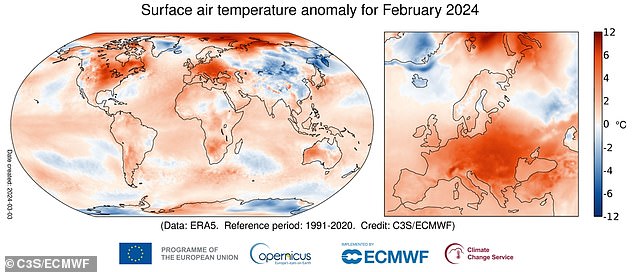
February 2024 was the warmest February on record globally, with an average surface air temperature of 56.3°F (13.54°C).


Men bathe in the sea at 14°C during a warm weekend, with the Sanguinaires Islands in the background, on the French Mediterranean island of Corsica, in Porticcio, on February 18, 2024.
“February adds to the long streak of records in recent months,” said Carlo Buontempo, director of the Copernicus Climate Change Service (C3S).
“As notable as this may seem, it is actually not surprising, as continued warming of the climate system inevitably leads to new extreme temperatures.
“The climate responds to the actual concentrations of greenhouse gases in the atmosphere, so unless we manage to stabilize them, we will inevitably face new global temperature records and their consequences.”
C3S, managed by the European Commission, analyzes temperature readings based on a variety of platforms and instruments, from weather stations to weather balloons and satellites.
The department’s readings refer to the average air temperature for the entire planet throughout the year, so they are lower than a single, typically “hot” temperature reading.
According to C3S, February 2024 is the ninth consecutive warmest month on record for that respective month.
It was 3.18°F (1.77°C) warmer than an estimate of the February average for 1850-1900, the “pre-industrial” reference period.
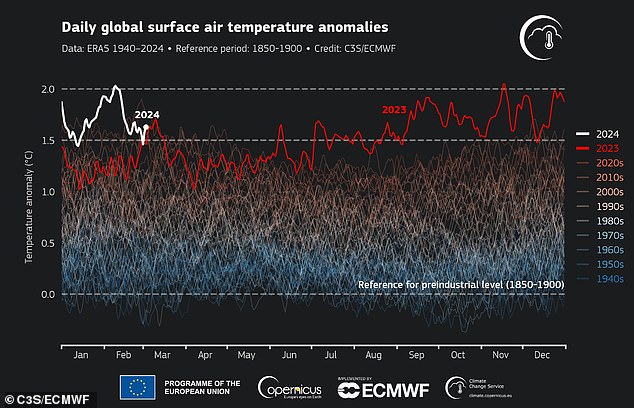

The graph shows the average daily surface air temperature anomalies (°C) relative to the estimated values for 1850-1900 for 2024 (white) and 2023 (red)


Daffodils bloom in St James’s Park with the London Eye in the background, London, February 23, 2024


Pictured is a snow-free ski slope at the Artouste ski resort in Laruns, in the Pyrénées-Atlantiques, southwestern France, on February 19, 2024.


A ski resort in Orlicke Zahori, in the Orlicke Mountains, Czech Republic, struggles with a lack of snow, on February 10, 2024.
The global daily average temperature was “exceptionally high” during the first half of the month, reaching 3.6°F (2°C) above 1850-1900 levels on four consecutive days (February 8-11).
This is concerning because a global goal is to keep the average global temperature within 3.6°F (2°C) and, if possible, 2.7°F (1.5°C) as part of the Paris Agreement, a binding climate treaty signed in 2016.
Fortunately, the news does not mean that we have exceeded the limits set by the Paris Agreement (since they refer to periods of at least 20 years in which this average temperature anomaly is exceeded).
Looking at Europe separately from the rest of the world, temperatures last month were 5.94°F (3.3°C) above the 1991-2020 February average.
Much of the above-average temperatures were experienced in central and eastern Europe, but they were above average in northern Siberia, central and northwestern North America, most of South America, throughout Africa, and in Western Australia.
CS3’s main metric for measuring how hot it is is air temperature, but it also tracks temperatures of the world’s oceans.
That is, it looks at sea surface temperature: how warm the water is near the surface of the ocean.
CS3 said the global average sea surface temperature for February 2024 was 37.91°F (21.06°C), the highest for any month in the data set and above the previous record for August. of 2023 (69.76°F/20.98°C).


People sit on the bank of the Seine River to enjoy the warm weather in front of the Pont des Arts in Paris on February 15, 2024.


A runner runs along the downtown Riverwalk during an unseasonably warm winter day on February 27, 2024 in Chicago, Illinois.


Skiers use a lift on a partly snow-covered ski slope at the alpine resort of Les Mosses in Ormont-Dessous, Switzerland, February 6, 2024. The mild weather of recent days in the Swiss Alps disrupted ski activity. alpine ski resorts
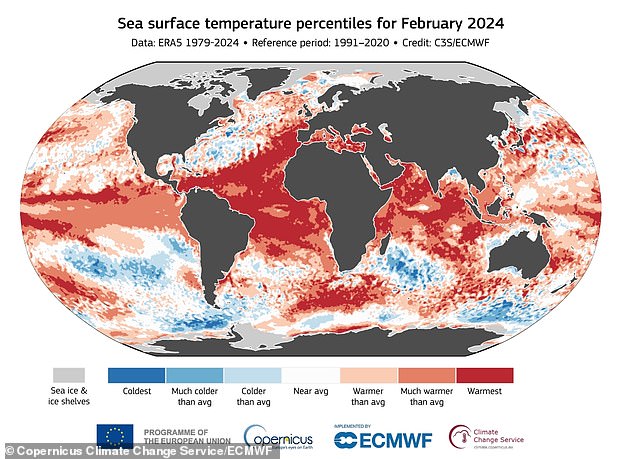

Pictured, sea surface temperature in February 2024. This is a separate metric to measure how hot the world is.
Looking ahead, next month of 2024 is likely to replace July 2023 as the hottest month on record.
The global average temperature for July 2023 was 62.51 °F (16.95 °C), the highest since records began in 1940 and well above the previous record of 61.93 °F (16.63 °C) established in July 2019.
Meanwhile, 2023 overall set the record for the warmest year on record, largely due to “unprecedented” global temperatures starting in June, fueled primarily by greenhouse gases.
Atmospheric concentrations of carbon dioxide and methane (the two most important greenhouse gases) continued to rise and reached record levels in 2023.
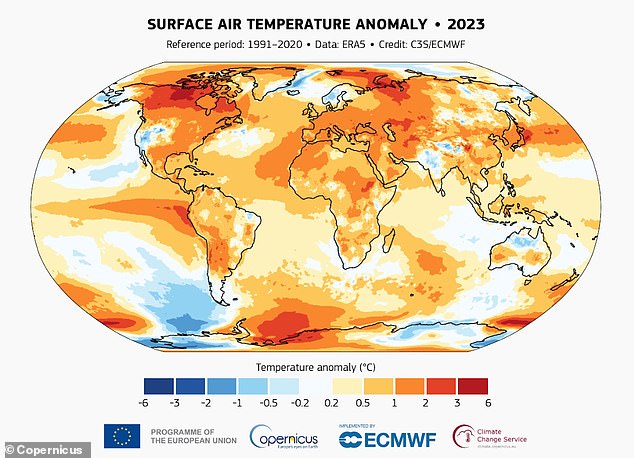

2023 is confirmed as the warmest calendar year in global temperature data records dating back to 1850. The global average air temperature was 58.96°F (14.98°C), about 0.3° F (0.17 °C) higher than the 2016 result.
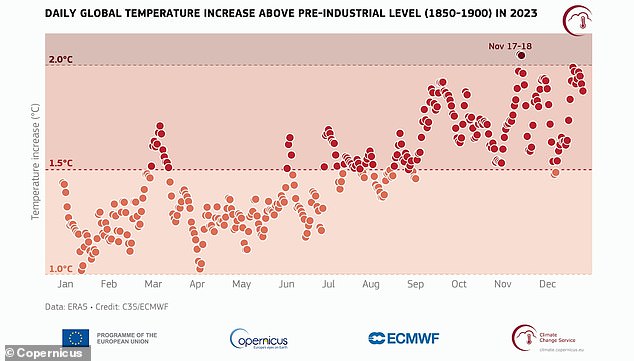

In 2023, two November days (17 and 18) were, for the first time, more than 2°C (3.6°F) warmer than the “pre-industrial” average
What’s more, each month from June to December 2023 was warmer than the corresponding month in any previous year.
Several months in 2023 were the hottest on record for that particular month, such as September, November, and December, as well as July (not just the hottest July on record, but the hottest month on record).
“2023 was an exceptional year in which climate records fell like dominoes,” said Samantha Burgess, deputy director of C3S.
“Temperatures during 2023 will likely exceed those of any period in at least the last 100,000 years.”
